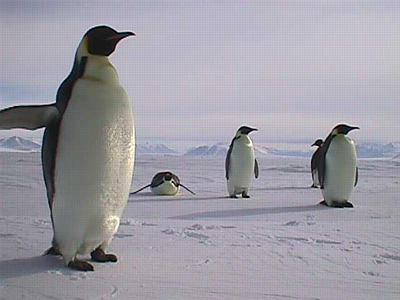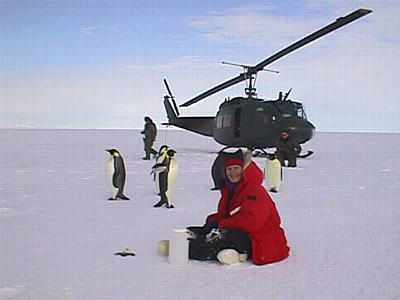
|
|
18 November, 1998
Today I had to pack all of my stuff up here at Lake Bonney because I'm
leaving camp in the evening. I had to tie up all loose ends-- my
experiments, my GPS points, my equipment, etc.
I woke up at 7:00 am and repacked my bags in the tent. I packed up my
sleeping bag, fleece liner, pillow, and mats back into my sleep kit
bag. I took all bags down into the Jamesway, so they would be ready to
go in the evening. John, Nina, Ben, and Jim were going to go ice coring
at Lake Miers, so it would be Chris, Ed, Mark, and I left in camp for
the day. I ate breakfast, made 3 loaves of bread once more, and talked
to Dan for a little while on the phone. I set up the Garmin once again
(the GPS device). This time it was set to use the differential plug, to
get the coordinates as accurately as possible. I trekked back to my
original sampling sites on the lake to get the S and E coordinates of
each of the sites. I grabbed a hammer on the way back and went up the
hill to take down my tent. I was able to get one of the tent sites on
Bonney Heights (what my group calls it)...a pretty nice site. The wind
was blowing fiercely, so I had to watch carefully that I wouldn't be
caught chasing my tent down the mountainside. Now I had four bags going
back to McMurdo...my 2 orange bags they gave us in Christchurch, my
sleep kit, and my tent. The last thing I had to remember to take was
the box of samples that I generated in the nutrient leaching experiments
(the timed experiments from several days ago).
I ate lunch and did a last-minute check on my e-mail...I'm trying to
keep up! I gathered ice berries so that the group coming back in would
have drinking water. I wrote in the Lake Bonney guest book...something
every guest must do upon visiting Lake Bonney. Chris mentioned that we
needed to get a few samples from the sea ice, too, for our experiments,
so he was going to have the helicopter drop us off at the sea ice edge
on the way back to McMurdo in the evening. I collected sampling
bags...he collected the sample bottle. Added bonus: we were maybe
going to see penguins...I couldn't wait!
The Kiwi helicopter picked Chris, Mark, and me up around 5:00 pm (along
with Jim, who was already on the helicopter) and dropped the rest of our
group off at Lake Bonney. We flew to the sea ice edge, to where we
could walk right up to open water. The Kiwis checked the ice depth with
a hand-driller before fully landing, and then we were able to get off of
the helicopter. In the distance were some Emperor Penguins. Within a
matter of minutes, the area surrounding all of us and the helicopter
were filled with about 10 penguins. I plopped down in the snow and was
immediately surrounded by about 5 of them, about 2 feet away from me!
They are beautiful birds (and so curious!). They have a yellow-orange
patch on the sides of their head and a crimson line along their beaks.
Other than that, they are black and white. I could see them blinking
their eyes and keeping an eye on everything. They didn't seem to be
fearful of us. I was in heaven... I think I took a total of 50 - 60
pictures in the next 45 minutes. They were amazing to watch. If I
would get up slowly, they would slowly waddle along behind me. I didn't
move very much because the Antarctic Treaty states that if any animal's
behavior is changing because you are there, you need to move farther
away. The penguins moved very slowly, swaying from side to side, every
once in a while they would fall on their bellies and slide along the
snow....very fun to watch! They would grunt every once in a while. I
would have liked to know what they were saying.
At the ice edge, I was able to see quite a few of them swimming. Many
of them splashed up out of the water and waddled along the ice and then
back into the water again. It was amazing that they could switch modes
of operation so quickly-- first swimming so adeptly and then waddling
along on land. I saw one Adelie Penguin swimming in the water (they are
smaller, black and white only, with a white ring around the eye).
Emperor Penguins are known as the world's largest penguins. They stand
over a meter high and can weigh up to 40 kg. It is the only Antarctic
bird that breeds during the winter. The male penguin incubates the egg
on his feet for about 66 days. The chicks only become dependent around
November through January. They eat the Antarctic silver fish, krill,
and squid. In order to catch their prey, they do what is called
pursuit-diving (where they dive very quickly downward to catch their
prey). The record dive stands at 535 m and 22 minutes. They are truly
amazing creatures, and I felt privileged to spend time with them...oh,
yeah, and we gathered the samples that we needed. : )
We returned to McMurdo around 7:15 pm, unloaded our stuff at Crary Lab,
and went to dinner. I had forgotten to call into housing that I was
returning to McMurdo and needed a room, so I stopped by the housing
office to obtain a room key for the next three nights (because I'm
leaving on Saturday!). I went back to Crary Lab, picked up my bags, and
returned to my room. I HAD to take a shower. I was on day 7 without a
shower (that's what the penguins were talking about..."Whew, you smell
that? She didn't even have the decency to shower for us!"). I showered
and returned to the lab so that I could transfer my sediment samples
into aluminum tins for drying overnight. Tomorrow I have to weigh the
samples, catalog them, and fill out transfer papers to ASA (Antarctic
Support Associates) so that they can do the analysis on them. I
finished at 11:30 pm and went to bed. Boy, did I sleep well! [I told
you I'm working hard!]

Another penguin picture. Aren't they beautiful? They really were very close. I don't have a zoom lens on my digital camera.

Emperor Penguins. They look so regal.

The Emperor Penguins swimming in the water around the ice edge. It was fun to see them "pop" in and out of the water.

Look how close the Emperor Penguins came to both me and the helicopter. They're a curious bunch!
Contact the TEA in the field at
.
If you cannot connect through your browser, copy the
TEA's e-mail address in the "To:" line of
your favorite e-mail package.
|
